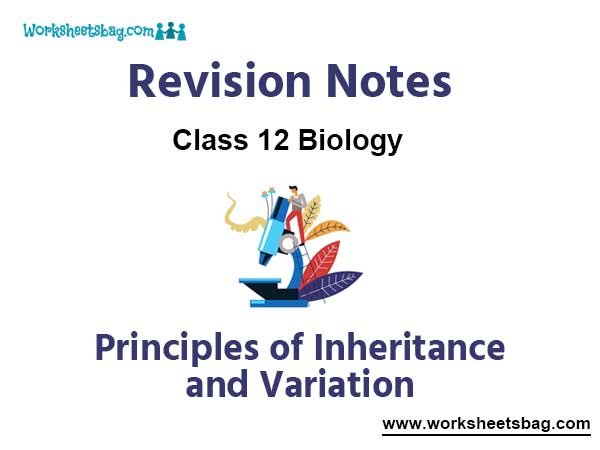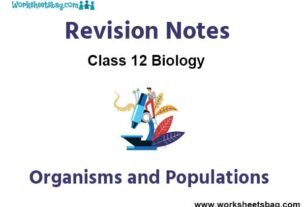Please refer to the Principles of Inheritance and Variation Notes Class 12 Biology given below. These revision notes have been designed as per the latest NCERT, CBSE, and KVS books issued for the current academic year. Students will be able to understand the entire chapter in your class 12th Biology book. We have provided chapter-wise Notes for Class 12 Biology as per the latest examination pattern.
Revision Notes Chapter 5 Principles of Inheritance and Variation Class 12 Biology
Students of Class 12 Biology will be able to revise the entire chapter and also learn all important concepts based on the topic-wise notes given below. Our best teachers for Grade 12 have prepared these to help you get better marks in upcoming examinations. These revision notes cover all important topics given in this chapter.
- Genetics is a branch of biology that deals with the study of heredity and variations. Heredity is the study of transmission of characters from parents to offspring or from one generation to the next. The characters that are passed from one generation to the next are called hereditary characters. Variations may be defined as the differences in characteristics shown by the individuals of a species and also by the offspring or siblings of the same parents.
- The term genetics was first used by W. Bateson (1906).
- Gregor Johann Mendel (1822-84) is called the Father of Genetics because he was the first to workout the patterns of heredity by performing experiments on garden pea plant (Pisum sativum).
GENETIC TERMINOLOGIES AND SYMBOLS
- Character is a well defined morphological or physiological feature of an organism, for example plant height.
- Trait is the distinguishing feature of a character, for example tallness or dwarfness.
- Gene is the unit of genetic information that determines the biological character of an organism.
- Allelomorphs or alleles refer to the two Mendelian factors which occur on the same locus on the two homologous chromosomes of an individual and control the expression of a character e.g., T and t, Y and y, R and r are pairs of alleles.
- Term allele was given by W. Bateson.
- Dominant allele is one of the factor of an allelic pair which can express itself whether present in homozygous or heterozygous state, e.g., T (tallness in pea), R (round seed in pea).
- Recessive allele is the factor of an allelic pair which is unable to express its effect in the presence of its contrasting alternative form in a heterozygote, e.g., t in Tt.
- The diploid condition in which the alleles at a given locus are identical is called homozygous or pure, e.g., TT or tt.
- Organism containing two different alleles or individual containing both dominant and recessive genes of an allelic pair, e.g., Tt, is known as heterozygous or hybrid.
- When only one allelic pair is considered in cross breeding, it is called monohybrid cross.
- When two allelic pairs are considered for crossing, it is called dihybrid cross.
- When there is involvement of more than two allelic pairs in a cross it is called polyhybrid cross.
- F1 generation is the generation of hybrids produced from a cross between the genetically different individuals called parents. For example, Tt individuals are produced in F1 generation from a cross between TT and tt parents.
- F2 generation is the generation of individuals which arises as a result of inbreeding or interbreeding amonst individuals of F1 generation.
- Hybrid vigour or heterosis is the superiority of hybrid over either of its parents in one or more traits.
- Genotype is the gene complement or genetic constitution of an individual with regard to one or more characters irrespective of whether the genes are expressed or not.
- Phenotype is the observable characteristic of an organism which is determined by its genes.
- The portion or region on chromosome representing a single gene is called gene locus.
- The aggregate of all genes and their alleles present in an interbreeding population is known as the gene pool.
- Pure line or pure breeding line is a strain of individuals homozygous for all genes considered. The term was coined by Johannsen.
- Punnett square is a checker board which was devised by R.C. Punnett and used to show the result of a cross between two organisms.
- Genome is a constitution of all the genes contained in a single set of chromosomes, i.e., in a haploid nucleus. Each parent, through its reproductive cells, contributes its genome to its offspring. A single genome is present in haploid cells, two in diploid cells and many in polyploid cells.

Back Cross and Test Cross
- A cross of F1 hybrid with either of the two homozygous parents is known as back cross. When F1 offspring are crossed with the dominant parents, all the F2 offspring develop dominant character. On the other hand when F1 hybrids are crossed with recessive parent, individuals with both the phenotypes appear in equal proportions.
- While both the crosses are known as back cross, the second one is specified as test cross. It is called so because it can be used to test genotype of a dominant phenotype. If dominant individual is pure (homozygous) it will produce only dominant trait in progeny.



QUANTITATIVE AND QUALITATIVE INHERITANCE

VARIATIONS
Variations are differences found in morphological, physiological, cytological and behavioural traits of individuals belonging to same species, race and family. Hereditary variations are transmitted from generation to generation whereas environmental variations are temporary and do not relate with last or next generation.

CHROMOSOME THEORY OF INHERITANCE
- Walter Sutton and Theodore Boveri (1902) postulated the “chromosome theory of inheritance”.
- The chromosome theory of inheritance states that the Mendelian factors or genes are located at specific loci on the chromosomes, and it is the chromosomes which segregate and assort independently during meiosis and recombine at the time of fertilisation in the zygote.
- Salient features of this theory are :
1. Bridge between one generation and the next is through sperm and ovum. the two must carry all the hereditary characters. Both the sperm and egg contribute equally in the heredity of the offspring.
2. Nucleus contains chromosomes. Therefore, chromosomes must carry the hereditary traits. Every chromosome or chromosome pair has a de nite role in the development of an individual.
3. The chromosomes retain their number, structure and individuality throughout the life of an organism and from generation to generation. The two neither get lost nor mixed up. They behave as units.
4. Both chromosomes as well as genes occur in pairs in the somatic or diploid cells. A gamete contains only one chromosome of a type and only one of the two alleles of a trait.
LINKAGE
- Linkage is the phenomenon of certain genes staying together and their inheritance from generation to generation without any change or separation due to their presence on the same chromosome. T. H. Morgan (1910) proved and defined linkage on the basis of his breeding experiments on fruit-fly, Drosophila melanogaster.
- Genes are arranged in a linear fashion on the chromosome. Some genes situated in close proximity are always inherited together i.e., become linked. Strength of the linkage between two genes is inversely proportional to the distance between the two. All those genes which are located in the single chromosome, constitute a linkage group. The number of linkage groups in a species corresponds to its haploid number of chromosomes, e.g., 23 linkage groups are present in man.

CROSSING OVER
- Crossing over is recombination of genes due to exchange of genetic material between two synapsed homologous chromosomes. It is the mutual exchange of segments of genetic material between non-sister chromatids of two homologous chromosomes, so as to produce recombinations of genes. The non-sister chromatids in which exchange of segments has occurred are called recombinants or crossovers.
- It results in new combinations of genes which are different from parents thus introduces variations. The variations are helpful in struggle for existence and adaptability to changes in environment. Useful recombinations are picked up by breeders for development of improved varieties. The frequency of crossing over is used for building linkage maps or chromosome maps.
SEX DETERMINATION
Sex determination is the method by which the distinction between males and females is established in a species.

SEX LINKED INHERITANCE
- Sex-linked inheritance is the transmission of characters and their determining genes alongwith sex determining genes present on the sex chromosomes, X and Y which are inherited together from one generation to the next. X-linked traits are more apparent in males than in females. Females generally function as carriers of X-linked disorders because recessive genes can express themselves in females only in the homozygous state. E.g., colour blindness, haemophilia etc.
- X-linked traits follow the pattern of crisscross inheritance where a parent passes the traits to the grandchild of the same sex through offspring of the opposite sex, that is, father passes the traits to grandson through his daughter while the mother transfers traits to her grand daughter through her son.
MUTATION
Mutation is the sudden inheritable discontinuous variation which appears in an organism due to permanent changes
in their genotypes. The term mutation was coined by Hugo de Vries (1901).

PEDIGREE ANALYSIS
- Pedigree is a chart showing a record of inheritance of certain traits for two or more ancestral generations of human beings or domesticated animals in the form of a diagram of family tree. Pedigree analysis is a system of analysis by following the movement and distribution of certain genetic traits. This system has following conventions:

- Pedigree analysis is useful in many ways like it helps to ll up the possible genotypes by knowing the phenotypes only. It helps to study the pattern of inheritance of a dominant or a recessive trait. The possible genetic makeup of a person for a trait can also be known with the help of pedigree.
HUMAN GENETIC DISORDERS

Table 1: Some known chromosomal abnormalities

Table 2 : Mendelian disorders



